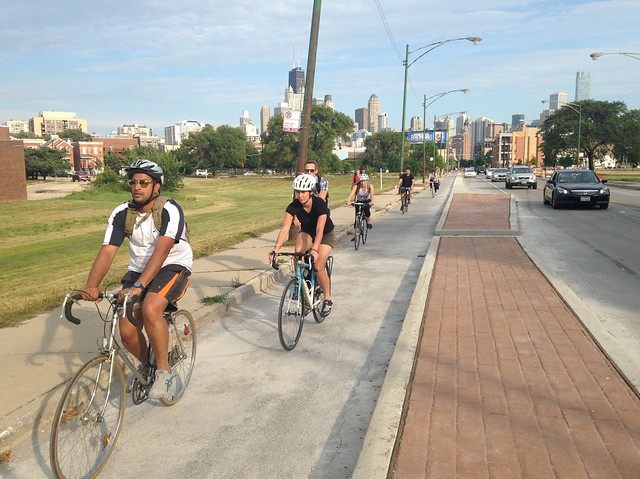Last week Mayor Lori Lightfoot released a citywide vision of trails and open space projects that she said would promote the health and well-being of all Chicago residents and visitors.
The new map provides a compelling vision that opens the door to funding many high-impact projects that community leaders have fought for over many years.
But by itself it will not make a meaningful difference in advancing the city’s climate, equity, and safety goals. Chicago still needs a safe, connected on-street bikeways network.
TRAILS VISION NEEDS MORE DETAIL
Walking and biking trails are hugely popular and can help improve community health and sustainability. When informed by strong community input, they can increase access to open space and help fill gaps in the walking and biking network.
Releasing the vision is an important first step to making these proposed trails a reality.
Most of the projects listed are in the early planning and design stages and have been for years. Residents and community leaders – including many in disinvested areas on the South and West Sides — have fought for decades in some cases to move them forward.
Here are a few examples:
- On the Far South Side, Deloris Lucas and other advocates have pushed the city and state to build a side path on 130th Street to help residents access the local grocery store.
- On the Far Northwest Side, residents have long advocated for the city to build the Weber Spur — a crucial trail connection to boost community health and strengthen local businesses.
- On the West Side, the North Lawndale community has been advocating for transforming part of the Altenheim Line into a pedestrian and bike path.
There are other projects featured in the vision that have yet to be developed. For example, a system of safe and comfortable routes on Chicago’s boulevard system serves as the backbone of the plan. The map labels these streets as routes that need to be “maintained and improved.”
But anyone who has ridden a bike on Diversey, Independence, or Garfield would tell you the streets are not currently safe for people on bikes. Bike lanes do not exist or are faded.
This vision provides an opportunity to create truly safe and comfortable routes on the boulevards by adding physically separated bike lanes.
NETWORK OF ON-STREET BIKEWAYS STILL NEEDED
While this vision is exciting, trails alone will not make biking a transportation option for all Chicagoans. It needs to be paired with a clear strategy for building a safe, connected network of protected bike lanes on the street.
Since the start of the pandemic, traffic crashes and fatalities have been on the rise and reports of speeding and reckless driving have spiked. You cannot have a low-stress bike network or make progress on Vision Zero without safe streets.
Protected bike lanes make streets safer for everyone and help encourage more people to ride. Most people are not comfortable riding next to cars and trucks without physical separation like concrete curbs or planters — not plastic.
For too long, Chicago has taken a patchwork approach to building bike lanes, using paint or plastic to temporarily mark lanes before weather or car and truck traffic limits their usefulness. Chicago’s overall bikeway mileage may be growing but the quality of most lanes is poor. The lanes are not connected in ways that make it easy for people to ride safely to schools, pick up groceries, visit a friend, or drop kids off at daycare.
Trails are only one part of a complete network. Chicago still needs a community-informed plan to build a citywide network of concrete protected bike lanes on major roads that connect to quiet residential streets and a growing network of off-street trails.
SEIZING THE MOMENT
We can do this — create a safe protected network on streets and an off-street trail system that together provides a meaningful alternative to driving.
Fortunately, there is lots of federal, state, and local transportation funding available that could be used efficiently on these long-planned trails and bikeways.
It is critical for the city to use this vision to advance and fund a safe and comfortable bike network as soon as possible.
Photo Credit: John Greenfield

